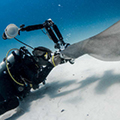Make a donation
The Museum is a charity and we rely on your support.
Make a donation today and support our 350 scientists who are working to build resilient habitats, protect vulnerable species and secure a sustainable future for our planet.

Douglas encountered this dugong in a sheltered, shallow bay on the Egyptian coast.
It was eating seagrass, its principal food, moving itself along on its flippers rather than its whale-like tail, which it uses for swimming. Every few minutes, after two metres or so of grazing, it would swim to the surface, open its nostrils and take several deep breaths. 'I approached him very slowly to gain his trust,' says Douglas, who took his portrait by lying flat on the sea floor. What struck him was the power of the dugong's muscular snout. It was obvious why the local dive operators had christened this particular individual Dyson: as it cropped the seagrass, it looked as if it was sucking it up with industrial power.

USA
Help us harness the power of photography to advance scientific knowledge, spread awareness of important issues and nurture a global love for nature.

